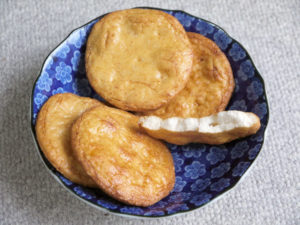
Senbei (煎餅) is a Japanese rice cracker that often has a flat and round shape.
This confectionery pairs well with green tea.
Although the origin of the word is unrelated, note that the first Chinese character of senbei is the same as sencha (煎茶).
In general, senbei is made with flour of ordinary Japanese rice (uruchimai).
It is baked or grilled.
Senbei existed in China during the Han dynasty (202 BC – 8 BC).
But there is a Japanese legend that says that an old woman named Osen (and that’s why they are called senbei) from present day Sōka city in Saitama prefecture, was selling dango and had to throw away some that she hadn’t sold.
Then a samurai told her that perhaps she could flatten them and roast them. Thus the senbei was born.
And since dango are round, once flattened the senbei also became round.
Sōka senbei are famous because of this story.
Senbei shouldn’t be confused with okaki and arare, which are different types of rice crackers.
It’s hard to explain what senbei tastes like, because there is a great variety of senbei with different ingredients.
But most of them have a crunchy texture.
Senbei are so popular that there are shops that specialize in them.
Below are some types of senbei:
Shōyu senbei (醬油煎餅), senbei coated with a mix of soy sauce and sugar.
Atsuyaki senbei (厚焼き煎餅), thick senbei.
Usuyaki senbei (薄焼煎餅), thin senbei.
Nori senbei (のり煎餅), senbei with nori seaweed wrapped around it.
Zarame senbei (ざらめ煎餅), senbei made with coarse sugar and soy sauce.
Agesenbei (揚げ煎餅), fried senbei.
Nuresenbei (ぬれ煎餅), senbei soaked in a sauce containing soy sauce, among other things.
Satō senbei (さとう煎餅), a senbei that has a sugar coating.
Ebi senbei (海老煎餅), a senbei that contains shrimp.
Finally, here’s an Amazon link in case that you’re interested in trying senbei.




